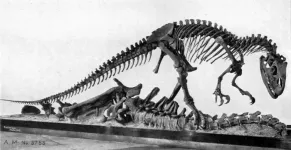UArizona researchers examine the relationship between loneliness and being alone
A new study finds that solitary time does not closely correlate with feelings of loneliness – unless a person spends 75% of their time alone.
2023-11-01
(Press-News.org)
In a world filled with endless connections and constant communication, the relationship between loneliness and aloneness is not always clear. Now, University of Arizona researchers have analyzed that relationship – and found that they are two different things that are not closely correlated.
People don't feel lonely until they spend three-quarters of their time alone, the study found. However, when their alone time goes beyond 75%, it becomes difficult for them to avoid feelings of loneliness.
Published in the Journal of Research in Personality in September, the study also concludes that among older adults, there is a particularly strong association between time spent alone and feeling lonely. The study was led by Alex Danvers, a former postdoctoral associate at UArizona, and Liliane Efinger, a former visiting graduate student.
The social network of people gets smaller as they get older, and the ability to spend time with others diminishes for many older adults, said David Sbarra, a UArizona professor of psychology and a senior author on the paper.
"Among adults 68 years and older, we found that loneliness is strongly connected with being socially isolated," Sbarra said.
Mentioning the 2023 U.S. Surgeon General's advisory about the pattern of increase in loneliness, Sbarra said attention increasingly has focused on loneliness as a health determinant.
"We are learning more and more about the importance of social connections for human health, and it appears that loneliness and isolation are related but distinct concepts," he said.
"We needed a good measure of how much time people spend alone, and that's why we started this research," said Matthias Mehl, a UArizona psychology professor, also a senior author of the study.
Over the course of his career, Mehl has developed a method for studying social activity in everyday life. The Electronically Activated Recorder, or EAR, is a smartphone app that records with participants' permission the sounds they make for 30 seconds every 12 minutes.
EAR is a useful tool for observing daily social behaviors, Sbarra said. In this study, the researchers used EAR to characterize time spent alone.
"Feeling lonely is different from being alone, and EAR is an exciting new method for assessing time spent alone," Sbarra said.
Overall, the study participants spent 66% of their time alone, and those who were alone for more than 75% of their time were the ones who felt the most lonely. On analyzing the result from the entire participant pool, there was only a 3% overlap between aloneness and loneliness.
In younger people, aloneness and loneliness are just two different things, Mehl said. They may feel lonely in a crowd, or they may not feel lonely when they are by themselves.
The case is different with older adults, Mehl said. In older people, since feeling lonely and being alone are tightly linked, being with others and socializing is the way to combat feelings of loneliness, according to Mehl. The strong relationship between the two was found in adults older than 67, and there was an overlap of about 25% between loneliness and aloneness in older people, he said.
The study involved over 400 participants with archival data collected in a series of studies completed over the last 20 years.
"For instance, we know if the person is on the phone, if they are driving, watching television or if they are interacting with a partner or a stranger," Mehl said.
Although EAR has many benefits, it is a time-consuming method for researchers to quantify the metrics of social behavior. To avoid hours of coding sound files and to more efficiently measure aloneness, Mehl is now working with a team to develop SocialBit, an app that runs on a smartwatch, analogous to commercially available fitness trackers.
Much as fitness trackers measure physical activity by counting steps per day, SocialBit will measure social activity by measuring minutes of conversations per day, Mehl said.
The device is expected to be rolled out in the next couple of years. The researchers are developing it for stroke patients during recovery, given that social isolation after stroke is significant, Mehl said.
"In order to facilitate more social connection, we first need to be able to measure it well," Mehl said. "Methods like SocialBit can tell people, 'You’ve been solitary for too long. It’s time to try to have a conversation.'"
END
ELSE PRESS RELEASES FROM THIS DATE:
2023-11-01
EMBARGOED FOR RELEASE UNTIL 4 P.M. ET, WEDNESDAY, NOVEMBER 1, 2023
MINNEAPOLIS – People who live in neighborhoods with lower socioeconomic status are less likely to receive clot-busting medications or undergo clot-removing procedures after they have a stroke than people who live in neighborhoods with higher socioeconomic status, according to a study published in the November 1, 2023, online issue of Neurology®, the medical journal of the American Academy of Neurology.
“These treatments can greatly reduce death and ...
2023-11-01
“Our principal component analyses showed a significant relationship between centro-cingulate cholinergic afferent changes and age in our Parkinson disease subjects.”
BUFFALO, NY- November 1, 2023 – A new research perspective was published in Aging (listed by MEDLINE/PubMed as "Aging (Albany NY)" and "Aging-US" by Web of Science) Volume 15, Issue 20, entitled, “Cholinergic centro-cingulate network in Parkinson disease and normal aging.”
In their new perspective, researchers Nicolaas I. Bohnen, Sygrid van der ...
2023-11-01
The marvels of modern technology – computers that fit in your hand, internet-connected refrigerators, and self-driving cars – are only possible thanks to the magic of materials like silicon. Likewise, the sci-fi gadgets of tomorrow will spring from the exotic new materials scientists are discovering today.
Harold Hwang, a physicist at the Department of Energy's SLAC National Accelerator Laboratory and Stanford University, has brought this future closer by sandwiching carefully crafted materials together and seeing what happens where they touch. His experimentation has uncovered a host of compounds with surprising ...
2023-11-01
New research from the University of Cincinnati found that daily strawberry consumption could help reduce the risk of dementia for certain middle-aged populations.
The research was recently published in the journal Nutrients.
Research background
In 2022, UC’s Robert Krikorian, PhD, and his team published research that found adding blueberries to the daily diets of certain middle-aged populations may lower the chances of developing late-life dementia. He said the current research into strawberries is an extension to the blueberry research.
“Both strawberries and blueberries contain antioxidants called anthocyanins, ...
2023-11-01
WASHINGTON, D.C., Nov. 1, 2023 — The latest issues of three American Psychiatric Association journals, The American Journal of Psychiatry, Psychiatric Services and Focus, are now available online.
The November issue of The American Journal of Psychiatry provides insights into psychotic disorders, such as the altered neurodevelopment and early symptom presentation associated with the risk of developing schizophrenia; racial and ethnic disparities in diagnosis of psychotic episodes; and predictors of first psychotic episodes and its treatment. Highlights include:
A Functional Connectome-Based Neural Signature ...
2023-11-01
LEXINGTON, Ky. (Oct. 31, 2023) — As people age, the DNA in their cells begins to accumulate genetic mutations. Mosaic chromosomal alterations (mCAs), a category of mutations acquired in blood cells, are linked with a 10-fold increased risk of developing blood cancer.
mCAs hold promise as a tool to identify people at high risk of developing certain cancers and diseases, but they have not yet been studied among a large, diverse cohort of people – a critical step required before such testing can be developed.
University of Kentucky Markey Cancer Center researcher Yasminka A. Jakubek, ...
2023-11-01
Collaborative ECHO Cohort research led by Phillip Sherlock, PhD; Maxwell Mansolf, PhD; and Courtney Blackwell, PhD of Northwestern University investigates the COVID-19 pandemic’s impacts on adolescents’ mental health. The findings suggest that some teens with a history of depression, anxiety, autism, and ADHD experienced more severe impacts than those without. This research, titled “Life Satisfaction for Adolescents with Developmental and Behavioral Disabilities during the COVID-19 Pandemic,” is published in Pediatric Research.
Although researchers ...
2023-11-01
Carnivorous dinosaurs might have evolved to take advantage of giant carcasses, according to a study published November 1, 2023 in the open-access journal PLOS ONE by Cameron Pahl and Luis Ruedas of Portland State University, Oregon and colleagues.
Carnivorous dinosaurs lived in ecosystems rich with both living and dead prey. The authors hypothesize that giant carcasses, like those of sauropod dinosaurs, might have provided a major source of food for large carnivores. To test this hypothesis, the researchers created an agent-based model, a simplified virtual simulation of a dinosaur ecosystem. This model was based on the ancient fauna of the Jurassic-aged ...
2023-11-01
During the 2020-2021 season of the National Basketball Association (NBA), which took place during Donald Trump’s failed bid at re-election, immigrant players for teams in regions with stronger far-right political sentiments were more likely to make game errors—highlighting the possible detrimental effects of such views on immigrant workplace performance. Benjamin Korman and Florian Kunze of the University of Konstanz, Germany, present these findings in the open-access journal PLOS ONE on November 1.
Prior research ...
2023-11-01
DURHAM, N.C.— A new Duke University-led study finds that Gulf War Illness (GWI), which affects approximately 250,000 U.S. veterans, significantly reduces their white blood cells’ ability to make energy and creates a measurable biochemical difference in veterans who have the disease.
“Historically, GWI has been diagnosed based on a veteran’s self-reported symptoms, such as exercise-induced fatigue, indigestion, dizziness, insomnia, or memory problems. There’s been no objective biochemical or molecular measurements doctors could use to diagnose it,” said Joel Meyer, professor of environmental genomics ...
LAST 30 PRESS RELEASES:
[Press-News.org] UArizona researchers examine the relationship between loneliness and being alone
A new study finds that solitary time does not closely correlate with feelings of loneliness – unless a person spends 75% of their time alone.






